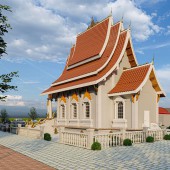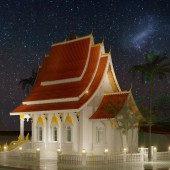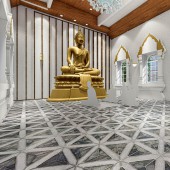Buddha Dhamma Chapel Buddhist Temple by Thongkhoun T. Pathana |
Home > |
 |
|
||||
| DESIGN DETAILS | |||||
| DESIGN NAME: Buddha Dhamma Chapel PRIMARY FUNCTION: Buddhist Temple INSPIRATION: When I was at a young age, my grandma took me to a Buddhist temple to offer food to our dead ancestor and she mentioned to me that my grandfather was a temple builder and an artist for many temples across the Laos Kingdom. In 1995, a Buddhist monk requested me to design a Buddhist temple in Rhode Island. That was my first commission as a student at Syracuse University. When visiting the royal capital and capital of Laos, Vientiane, in 2000, I felt attractive to the Buddhist architecture and artworks and an opportunity to learn about my heritage. The temples are known throughout the Golden Age or during the Western Renaissance era. It was called Wat Xieng Thong. Since 1995, I became an advisor & design the Buddha Dhamma Chapel is my Master Venerable Bounthanh Prasavath until March 1, 2022, when he passed away in Rhode Island. UNIQUE PROPERTIES / PROJECT DESCRIPTION: The unique thing about the Buddha Dhamma Chapel, is the structure and shaping of the building in a forest setting. The complexity and articulation of the structure system into modern architectural style is based on the western interpretation of Buddhist architecture in the diaspora. The building is build as a whole sculpture that are carved out from a mountain. A new transformation of the Buddhist language into Lao-Modern architecture is that “symbols and themes, in terms of architecture, are not redefined but interpreted and adapted within the Buddhist religious expression,". OPERATION / FLOW / INTERACTION: A Laotian American Buddhist temple organization, a Theravada Buddhist, who came to the United States during the Vietnam War. Many of the Laotian Americans reside in the Northeast of the US, about 30 minutes from the heart of Boston, MA and 10 minutes from Lowell, Ma, second of the largest Asian Americans living in the USA, since the Vietnam War, many settled in the Northeast. The community built a Buddhist temple to resemble their homeland, the former of the Kingdom of Laos. PROJECT DURATION AND LOCATION: The project started on June 11, 2015, when the Town of Westford, Ma, approved the Conservation Commission Planning and Building Permit Approval in 2017. The ground breaking took place in Spring 2017 and the construction was about 90% in 2020 before the pandemic stopped the project for the final roofing and interior finishes and lack of donations and community hardship during inflation throughout the world. The temple and community hope to resume the roof finishes and interior by the end of Winter 2023, when funding becomes available. |
PRODUCTION / REALIZATION TECHNOLOGY: The project is designed to be simple material; steel and concrete with a finish of Sto Milano stucco, and coating of the lotusan system. The Buddhist monks used the ancient Angkor Wat techniques to create stacking bricks to form the profiles of the doors, windows and the base of the chapel. The high base, doors, windows and roof finial are to be decorated with Buddhist art and painted in gold color. The interior wall is finished with frescoes and painted from Buddhist stories. The ceiling had to be installed with both wood to give a peace and harmonious feeling during the chanting. SPECIFICATIONS / TECHNICAL PROPERTIES: The building design is unique because of the site characteristics on a sloped hill and surrounded by forest. The building is 7620 mm x 21219 mm, with an interior of 7620 mm x 9144 mm and the portico is 3048 mm and the height is 13716 mm high from the ground to the ridge of the roof. The base of the building is 1524 mm from the eyes' sight line in perspective. The Budhha Dhamma Chapel is a symbol of Buddha resting facing the East. Create a perfect place like a lotus, springing out from the forest, a place where the community escapes from the city life to meditate and learn the teachings of a Buddha. TAGS: Pathana architecture, Wat Buddhabhanana, Watlao Buddhovath, Watlao, Lao architecture RESEARCH ABSTRACT: The program had divided into three categories, reflecting three realms or aspects of Buddhist religious iconography and the Ultimate Goal of Buddha Dharma (the three worlds). The three primary Buddhist structures are: first, the various facilities needed to sustain the life of the monastery (Kuti or viharas); second, the stupa or pagoda (the Great Bodhi Tree) Buddha Chapel; third, the imagery of Buddha, known as the lotus. These elements concerned with contemporary issues can be explored through the public, private, suburban, ritualistic levels of the sanctuary and shrine. Whatever the form of the structure, a Buddhist worship involves circumambulation, a custom easily followed in the context of a freestanding stupa. The vehicle of Lao architecture studies is to search for the meanings in one 's culture and historical background in terms of the symbols, images, and metaphors that it represents. Regarding the caves, sculptures, art, and other Laotian Buddhist elements, they began to generate formal strategy in practice. This allows architectural interpretation to integrate both organization and programmatic elements within the condition of the city and become an ideal within contemporary society. Can a speculation of 'shrine or Buddha Chapel' be used theoretically? It represents both the icon of the temple and the image of Buddha. What defines the complex relationship between an icon and a building? This leads to the investigation of the city's history, demographic and cultural identity of the Laotian American community. CHALLENGE: Exploring the "Laotian Buddhist practice in terms of the Buddhist architectural form" is the main goal of this study and studies. According to speculation and interpretation, form expression is portrayed by its topics, languages, metaphors, and spiritual forms. Buddhist forms have a consistent vocabulary, but their societies and cultures are constantly transitory in both space and time. In terms of architecture, symbols and motifs are not redefined but rather interpreted and modified in the expression form and shape. It is expected that it will be re-presented and re-interpreted in modern Buddhist architecture as program, structure and material are being articulated. In terms of culture, ritual, ceremony, festival, tradition, physical orientation, and the sacred structure where the faith is practiced, the site selection must represent some specific aspects of the Buddhist religion. Buddhist forms have a consistent vocabulary, but their societies and cultures are constantly transient in both space and time. The Buddhist monasteries are oriented towards the east in accordance with the site's Buddhist cosmology (a representation of awakening). Incorporating water motifs into cosmological imagery is important. Through the iconographic representation of imagery in Buddhist religious monasteries and through its role in ritual activities in the temple, these components create their own language. The issue of site selection is unlike traditional or Laotian mythology. The Buddhist temples in American cities have been formed from their own culture and history, removed from the Laotian Buddhist religion. The so-called "congregation and contemplation" is related to both the American city and its way of life. These investigations will allow me to determine the most suitable site for the focal point of the Laotian Buddhist temple center. That is the challenge of Buddhist temple language and meaning such as form & shape, material & color, and artwork. ADDED DATE: 2023-03-02 20:21:45 TEAM MEMBERS (1) : IMAGE CREDITS: Image #1: Architectural Design Image #2: Architectural Design Image #3: Architecture Image #4: Night View Image #5: Interior Sectional PATENTS/COPYRIGHTS: Copyrights belong to DP Evers Architecture & ThatDesign & Pathana Architecture |
||||
| Visit the following page to learn more: https://bit.ly/3ZLsFLr | |||||
| AWARD DETAILS | |
 |
Buddha Dhamma Chapel Buddhist Temple by Thongkhoun T. Pathana is Runner-up for A' Design Award in Architecture, Building and Structure Design Category, 2022 - 2023.· Read the interview with designer Thongkhoun T. Pathana for design Buddha Dhamma Chapel here.· Press Members: Login or Register to request an exclusive interview with Thongkhoun T. Pathana. · Click here to register inorder to view the profile and other works by Thongkhoun T. Pathana. |
| SOCIAL |
| + Add to Likes / Favorites | Send to My Email | Comment | Testimonials |








